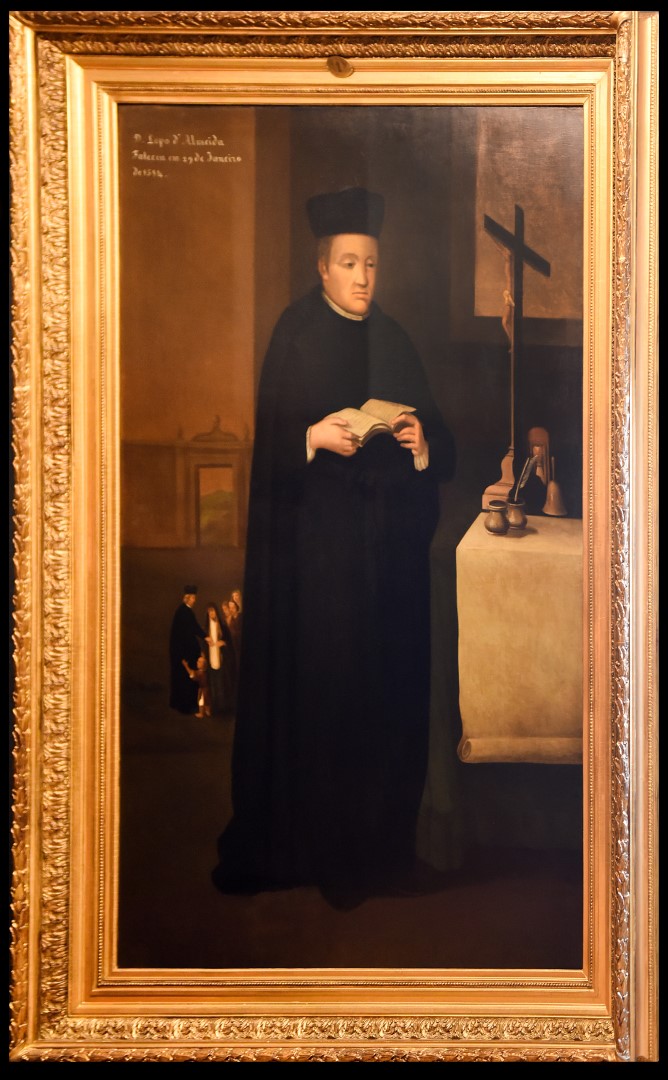works




Portrait of D. Lopo de Almeida
Painting that represents one of the most important benefactors of Misericórdia do Porto.
Pintado em 1890 por Vitorino Ribeiro, inspirado na obra de Francisco Mendes Lima, o retrato de D. Lopo de Almeida pode ter como inspiração o de Manuel Fernandes de Calvos, outro grande benfeitor da Misericórdia. Essa influência é encontrada em sua composição, particularmente em algumas figuras. De fato, crianças, religiosos e mendigos, que D. Lopo escuta e ajuda ao ar livre, se assemelham à figura mencionada, onde aparecem em uma situação semelhante. O cromaticismo também usa tons de terra e marrom avermelhado.
D. Lopo surge no cenário interno, como uma figura de meia-idade, de pé, vestindo vestes sacerdotais, orando diante de uma cruz e segurando nas mãos um livro de orações. Fica adjacente a uma mesa sobre a qual são colocados um cartucho de tinta, um sino e outros objetos. Um pergaminho embaixo do cartucho revela suas disposições testamentárias. Uma porta estabelece a separação entre os dois cenários que, alegoricamente, remetem para a figura retratada, dividida entre os mundos íntimo e mundano.
D. Lopo de Almeida
Este importante benfeitor tem uma presença proeminente e onipresente na história da Misericórdia do Porto. Foi seu legado que permitiu uma maior autonomia da instituição em um momento em que ainda era muito dependente do apoio real.
It is believable that D. Lopo was born around 1525. He belonged to the lineage of the Almeidas with connections to the nobility of Abrantes, protected by King João II. He was the fifth child out of12 (7 brothers and 5 sisters).
His education and his own life were marked by significant geographical mobility. He spent time in his childhood and adolescence, with his great-uncle Jorge de Almeida, Bishop of Coimbra, in order to pursue a clerical career. In 1544 D. Lopo goes to Bordeaux with a scholarship to study grammar and Latin, heading to Paris in 1546. Two years later he is living in Flanders and returns to Portugal in 1550. At the end of that year he was arrested by the Inquisition under the charge of conversion to Lutheranism, having abjured, that is, renounced that religion that the Inquisition considered as a false one. He was released from prison in August 1551, after a pardon granted by Cardinal D. Henrique
.
It is imperative to emphasize his connection with King Filipe II of Spain, at the time of the Portuguese crown annexation process in 1580. The services offered earned him the position of chaplain of the Hispanic monarch.
On January 29th, 1584 he dies in Madrid. By testament of the 25th of the same month, he bequeathed his abundant possessions to the Santa Casa da Misericórdia do Porto, as long as it meets certain conditions. The first and most important was to continually help the sick and provide them with everything they needed, permanently and continuously. His entire fortune, he adds, would have to be spent on healing the poor. The experience of the Misericórdia do Porto in this area showed that the care for the poor patients required a suitable place for that purpose. For efficiency reasons, the institution felt it would have to build a new hospital to treat the sick. This, however, only came about two or three decades later.
However, the Provedor and the Administrative Board were pressured to carry out something concrete for the poor sick, forced by the requirements of D. Lopo de Almeida. The testament stipulated that, if the Misericórdia do Porto did not fulfilled the rules, the hastate would, successively, pass to the Misericórdia de Braga or to Lamego. Therefore, the Provedor, the Registrar and the Administrative Board tried to adapt the old Rocamador facilities (which had been released in 1587 by the Castilian military chiefs who, after the conquest of Portugal in 1580) in order to provide it with hospital characteristics. Not being, therefore, an entirely new institution, it seems acceptable that the Rocamador has been chosen to give initial compliance to the testament of D. Lopo de Almeida.
A curious fact of the generous testament contemplating the Misericórdia do Porto is that the benefactor was not born in Porto, nor is there any knowledge that he has ever lived in this city.
It was decided, in 1605, to build the new hospital, according to the inscription that exists in the Gallery of Benefactors. In mid-1610 the new home opened its doors to the first patients, although work continued until 1615.
For nearly two centuries the D. Lopo de Almeida hospital served the people of Porto and beyond. Even today, after more than 400 years, on January 29 of each year, the Misericórdia promotes the celebration of a mass for the soul of this benefactor and, in accordance with one of his testamentary dispositions, dresses five poor people.
D. Lopo de Almeida's Itinerary
MMIPO
> Sala 01 - História e Ação da Misericórdia do Porto: Hospital de Rocamador e Hospital de D. Lopo de Almeida
> Sala 02 - Benfeitores: Livro de Honra em Memória dos Benfeitores
> Galeria de Benfeitores: Descrição aludindo ao Hospital de D. Lopo
> Igreja Privada: Urna de D. Lopo de Almeida
Rua das Flores / Rua dos Caldeireiros
> Antigo Hospital de D. Lopo de Almeida
D. Lopo de Almeida
Joaquim Vitorino Ribeiro
1890
Cópia de uma amostra de Francisco Mendes Lima
Óleo sobre tela


.jpg)

